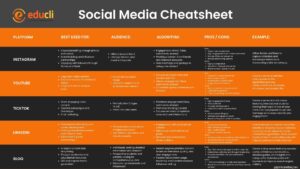Leveraging social media to promote to international students
In the age of digital transformation, colleges must adopt innovative marketing strategies to attract international students. Social media platforms play a crucial role in connecting with international students. Each platform has unique features, audience demographics, and algorithms that can be leveraged to create effective marketing strategies. Here’s a brief introduction to some of the most popular social media platforms and how they can be used for marketing to international students.
Which social media platforms should I use?

Best Used For:
- Visual storytelling through photos and videos
- Brand building and influencer partnerships
- Engaging with followers through Stories and Reels
Audience:
- Millennials and Gen Z
- Lifestyle, fashion, and travel enthusiasts
Algorithm:
- Engagement-driven (likes, comments, shares)
- Prioritises content from friends and followed accounts
- Uses hashtags and geotags to categorise content
Pros:
- Visual-centric platform
- High engagement with stories and reels
- Strong influencer presence
- Robust advertising options
Cons:
- Highly competitive
- Algorithm changes frequently
- Requires high-quality visuals
Example:
Utilise Stories and Reels to capture attention and encourage interactions showcasing a day on campus.
YouTube
Best Used For:
- Long-form video content
- Educational and informational videos
- Vlogs and virtual campus tours
Audience:
- Broad demographic range
- Education seekers and entertainment viewers
Algorithm:
- Focuses on watch time and session duration
- Viewer engagement (likes, comments, shares)
- Consistent upload schedules are favored
Pros:
- Long-form content potential
- Searchable content
- Monetisation opportunities
- Large, diverse audience
Cons:
- High production value required
- Competitive platform
- Time-consuming content creation
Example:
Create a series of detailed video guides on the application process, campus facilities, showcase of courses, and student life. Include testimonials from current international students and provide subtitles in multiple languages.
TikTok
Best Used For:
- Short, engaging video content
- Creative campaigns and challenges
- Viral marketing
Audience:
- Primarily Gen Z (ages 16-24)
- Trend-focused users
Algorithm:
- Prioritises engagement (likes, comments, shares)
- Promotes trending content
- Focuses on video completion rates and user interactions
Pros:
- High engagement rates
- Viral potential
- Younger demographic
- Creative content opportunities
Cons:
- Short content lifespan
- Limited demographic reach
- Requires frequent content updates
Example:
Create a series of short videos featuring international students sharing their experiences at your institution. Use popular music and hashtags to increase visibility and engagement.
Best Used For:
- Professional networking and career development
- Sharing educational content and industry news
- B2B marketing and partnerships
Audience:
- Professionals and students in higher education
- Job seekers, recruiters, and industry experts
Algorithm:
- Engagement with professional content
- Relevance and timeliness of posts
- Network and connections-driven visibility
Pros:
- Professional network
- B2B marketing potential
- High-quality leads
- Industry-specific groups
Cons:
- Slower growth compared to other platforms
- Less emphasis on visual content
- Professional tone required
Example:
Publish articles on LinkedIn about the benefits of studying at your institution, including career opportunities for international graduates. Share success stories of alumni and collaborate with industry partners to host webinars.
Blogs
Best Used For:
- In-depth content and storytelling
- Thought leadership and educational resources
- SEO and organic traffic generation
Audience:
- Individuals seeking detailed information and research
- Prospective students and parents looking for comprehensive guides
- Education professionals and influencers
Algorithm:
- Search engines prioritise content based on relevance, quality, and user engagement.
- Factors like keyword usage, backlinks, and content structure influence ranking.
Pros:
- High SEO value and organic traffic potential
- Establishes authority and thought leadership
- Provides detailed and comprehensive information
Cons:
- Time-consuming to create and maintain
- Requires consistent updates and high-quality content
- Competition for search engine rankings can be high
Example:
Create a blog series featuring success stories of international students, detailed guides, and insights into campus life. Optimise posts with relevant keywords to improve search engine visibility and attract prospective students.
Strategies for engagement
- Showcase Campus Life
Strategy: Campus Tours and Student Testimonials
- Example: Create a virtual campus tour video that highlights key facilities, scenic spots, and unique aspects of your college. Include student testimonials from current international students sharing their experiences.
- Tip: Use engaging narration and captions to ensure the video is accessible to non-native English speakers.
- Highlight Academic Excellence
Strategy: Faculty Interviews and Class Previews
- Example: Produce videos featuring interviews with distinguished faculty members discussing their research, teaching philosophy, and the courses they offer. Include footage of actual classes and labs.
- Tip: Incorporate subtitles and translations to make the content more inclusive.
- Promote Extracurricular Activities
Strategy: Showcase Clubs, Sports, and Cultural Events
- Example: Document major events such as cultural festivals, sports meets, and club activities. Highlight the diversity and inclusivity of the campus community.
- Tip: Use a mix of short clips and longer feature videos to cater to different viewing preferences.
- Offer Virtual Open Days
Strategy: Live Q&A Sessions and Webinars
- Example: Organise live-streamed Q&A sessions with admissions officers and current students to answer prospective international students’ queries. Host webinars on the application process, visa requirements, and scholarship opportunities.
- Tip: Promote these events well in advance through social media and email newsletters to maximise participation.
- Collaborate with Influencers
Strategy: Partner with Student Vloggers and Alumni
- Example: Collaborate with current international students or alumni who are active on YouTube to create vlogs about their journey, challenges, and success stories. These authentic narratives resonate well with prospective students.
- Tip: Ensure that the influencers have a genuine connection to the college and can provide honest, relatable content.
- Utilise Social Media Platforms
Strategy: Cross-Promote Content on Various Channels
- Example: Share YouTube videos on platforms like Facebook, Instagram, TikTok, and LinkedIn to reach a wider audience. Use snippets or teasers to drive traffic to the full videos on YouTube.
- Tip: Optimise video titles, descriptions, and tags with relevant keywords to improve searchability and engagement.
- Provide Multilingual Content
Strategy: Offer Videos in Multiple Languages
- Example: Produce videos in various languages spoken by your target international markets. Alternatively, use subtitles and translated transcripts for English videos.
- Tip: Engage international students or alumni to help with translations and to ensure cultural relevance.
- Share Success Stories
Strategy: Alumni Success Stories and Career Outcomes
- Example: Create videos showcasing successful alumni, particularly international graduates, and their career achievements. Highlight how the college supported their professional journey.
- Tip: Focus on diverse fields and geographical locations to demonstrate the global impact of your institution.
Conclusion
By strategically leveraging content on social media, colleges can effectively attract and engage international students. The key is to create authentic, informative, and engaging content that highlights the unique value propositions of your institution.
By understanding the strengths, audience, and algorithms of these social media platforms, institutions can tailor their marketing strategies to effectively reach and engage international students. Each platform offers unique opportunities to showcase the benefits of studying at your institution, fostering a global community of learners.
Embrace the power of visual storytelling to make a lasting impression on prospective students worldwide.
#SocialMediaMarketing #InternationalStudents #TikTokMarketing #InstagramMarketing #YouTubeMarketing #LinkedInMarketing #DigitalMarketing #StudentRecruitment #StudyAbroad #HigherEducation #EdTech #SocialMediaStrategy #GlobalEducation #MarketingTips #StudentEngagement #EducationMarketing #CampusLife #StudentExperience #VirtualCampusTour #UniversityMarketing





Leave A Comment